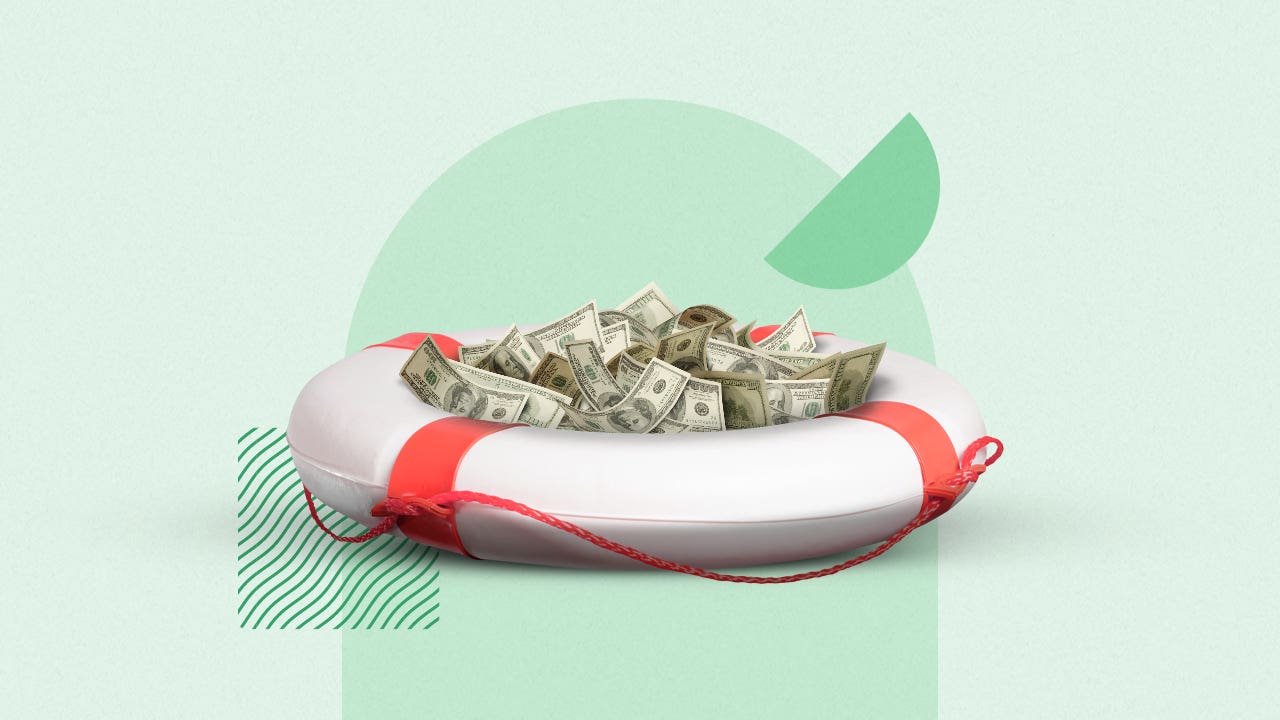Emergency fund amount: How much should you have in emergency savings?

The Bankrate promise
At Bankrate we strive to help you make smarter financial decisions. While we adhere to strict , this post may contain references to products from our partners. Here's an explanation for .
Experts typically recommend you have enough in your emergency fund to cover three to six months’ worth of expenses. The goal with emergency savings is to provide a cushion in your finances to cover unexpected expenses, such as a home repair or a sudden loss of income.
Bankrate’s financial regrets survey shows that having inadequate emergency savings can lead to increased stress levels. Of the people who say not saving enough for emergency expenses was their biggest financial regret, 27 percent say their stress increased greatly between June 2022 and June 2023, according to Bankrate.
For some, following the standard advice of three to six months of living expenses might be sufficient. Others, however, may prefer to save more or less than that amount, depending on factors such as income, cost of living and household size. That savings can go into a money market or high-yield savings account, where it can grow with interest and have some liquidity.
If you’re not sure how much to save for the unexpected, here are some scenarios to consider.
Emergency fund statistics
Bankrate’s latest emergency savings report found that:
- A majority of U.S. adults (57 percent) are uncomfortable with the level of emergency savings they currently have.
- Only 44 percent of U.S. adults say they have enough emergency savings to cover at least three months’ worth of expenses.
- More than 6 in 10 respondents (64 percent) say they’d need enough money saved to cover at least six months of expenses to feel comfortable with their savings.
- Over a third (36 percent) of people have more credit card debt than emergency savings.
- Nearly one-third (31 percent) of Gen Zers (ages 18-26) do not have emergency savings — more than twice as many as the 15 percent of baby boomers (ages 59-77) who have no emergency savings. Baby boomers are also more than three times as likely to have enough savings to cover six months or more of expenses as Gen Zers (47 percent and 13 percent, respectively).
- Annual income also greatly factors into how much someone has in their emergency savings — households with a yearly income under $50,000 are more than seven times more likely to have no emergency savings than households who make $100,000 a year or more.
When you might want a bigger emergency fund
Saving several months’ worth of earnings seems like a daunting task. One thing to remember, though, is that building an emergency fund means saving up to cover basic living expenses, not replacing your entire income. So, if your monthly expenses add up to $2,500, you’ll need to save $7,500 to reach three months of emergency savings.
There are times, however, when you might want to continue saving beyond experts’ recommendations.
Rarely would I advise someone to have less than three months in an emergency fund, but there are many cases [where] I would advise more… If you know you make imprudent decisions whenever money feels a little tighter, then it’s time to up the emergency fund.
— Ryan Derousseau, CFPFinancial Planner at United Financial Planning Group
Some instances when it makes sense to have a bigger emergency fund include:
- Your income is unstable: If you lack job stability or work in a high-risk industry, you may want to save more to make up for the possibility of having no income.
- You are self-employed: If you work for yourself, having a large emergency fund can help you get through times of fluctuating income throughout the year.
- You are retired: Having adequate savings is key if you’re retired and much of your income comes from your investments accounts.
- You have medical bills: If you’re dealing with medical issues that may require surgery or ongoing medical care, saving beyond the norm can help bridge the gap when insurance doesn’t cover all of your medical bills.
- Uncertainty in your life: Unexpected emergencies are a part of life, but there are times when you may be more vulnerable to added costs. If you drive an older, unreliable car or know your home will need some large repairs down the road, having extra savings can protect you in the long run. For single parents with kids at home and no secondary source of income, saving money can provide some peace of mind to know they are cared for regardless of what happens.
- Caring for dependents: If you have children or other dependents relying on you for care, it’s important to factor the costs of caring for them into your emergency fund.
- There’s an economic crisis: Global and national events like a recession or a pandemic are out of your control. During times like these, it’s always nice to know you have money saved to cover the unexpected.
When you might want less emergency savings
The more security you have, the less emergency fund you need (to a point).
— Ryan Derousseau, CFPFinancial Planner at United Financial Planning Group
Below are some reasons why you may buck traditional advice and carry leaner emergency savings.
- You have few expenses relative to your income: Depending on your situation, you may not have very many living expenses. Maybe you don’t own a home or car, or they are paid off already. If your living expenses take up only a small portion of your income, you may be fine with a smaller emergency fund.
- You have no dependents: Having children and other dependents often means higher expenses and more responsibility. You have to make sure you’re covered if something happens and you’re unable to work or provide for your family. If you have no dependents, though, you don’t need to save more money for others’ living expenses.
- You have credit card debt: If you have high-interest credit card debt, you may be better off building a smaller emergency fund and putting the rest of your money toward getting out of debt. Focusing on getting out of debt can help you save more in the long run by canceling out expensive interest charges. However, it’s still important to keep saving and contributing to a savings account with a high yield so your money can grow.
How much emergency savings should I have?
Personal finance is personal. What might be right for one person may not be the best option for another. It’s good to listen to financial experts and understand why they advocate saving a certain amount, but ultimately what matters is whether you’re comfortable with your emergency savings. That could mean two years or two months of emergency savings, depending on your goals. As long as your savings doesn’t sabotage other financial goals, set aside whatever you need to avoid worrying about paying for the unexpected.
“The more unstable your income is, the more you should probably keep in an emergency fund. Also, the higher your insurance deductibles are, the more you should be keeping in an emergency fund,” says Erik M. Baskin, founder of Baskin Financial Planning based in Sugarcreek Township, Ohio. “A family that has two stable incomes and no kids needs much less in emergency savings than a single income household with four kids.”
If you’re not covered as much as you’d like, create a savings plan to get you there, even if it means starting slow with $10 to $100 a month. Look at your budget and monthly income to determine how much you need for living expenses and how much you can save and invest in other areas of your life, like emergency savings.
To get more insight on how much and what strategies to save for emergencies, consider working with a financial advisor for personalized help.
Frequently asked questions
-
When shopping around for an account for your emergency savings, three important characteristics to look for are: low risk, high yields and liquidity. You don’t want to keep emergency savings in stocks and bonds, where there’s a risk of losing that money. It’s also a good idea to avoid keeping it in CDs, since if you need to withdraw the money, there may be a high penalty fee. Money market accounts and high-yield savings accounts are generally the best places to put emergency savings.
-
Emergency funds are designed for unexpected expenses and sudden losses of income. That includes things like a broken car, losing a job, sustained injuries or home repairs.
-
There are many ways to start saving each month and build an emergency fund. The first step is to make a monthly budget. This can help you not only determine how much your living expenses are but also where you can find room for cutting back in certain areas and saving more. You’ll want to contribute to your emergency fund little by little, aiming to save a certain percentage of your paycheck each month as well as windfalls.
-
To increase your emergency savings, consider finding new ways to save. Some ways to start saving money right away include canceling unnecessary subscriptions, switching to a higher-yielding bank account, selling used items and automating savings.
—Kevin Payne contributed to a previous version of this article.
Related Articles



